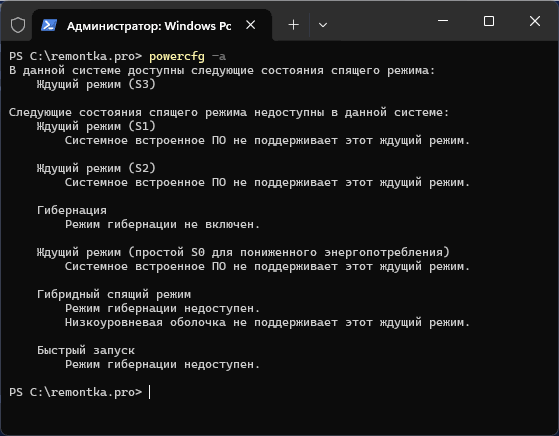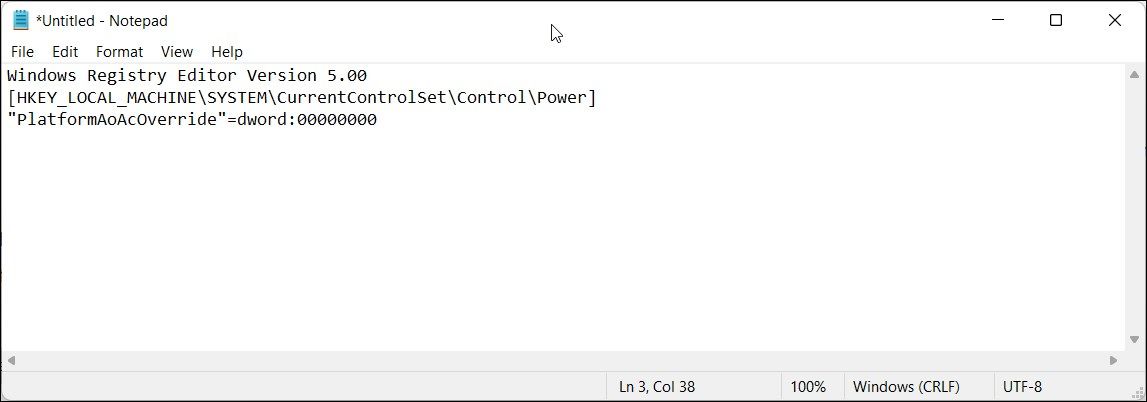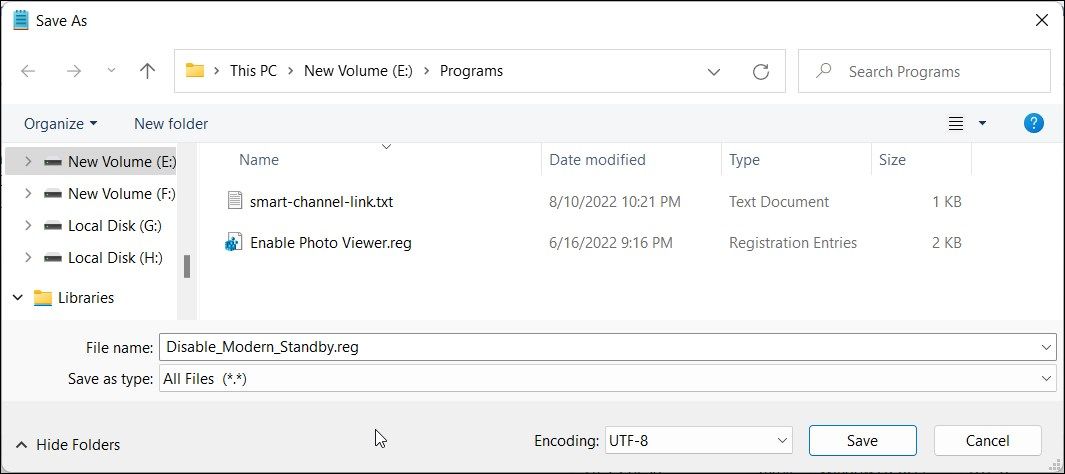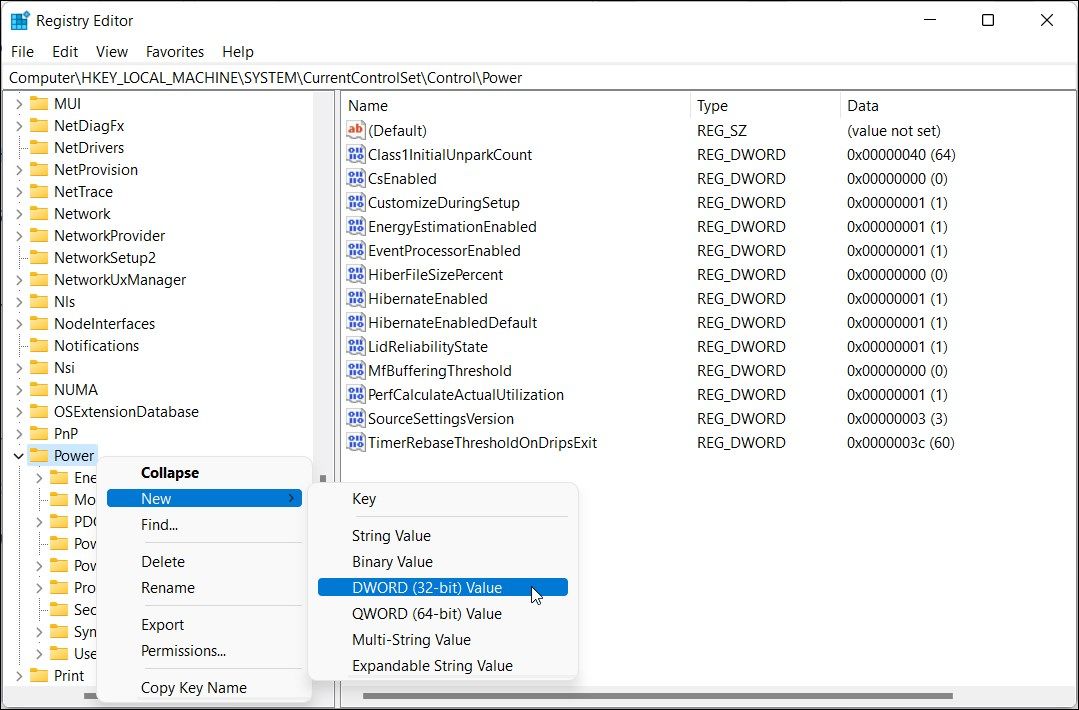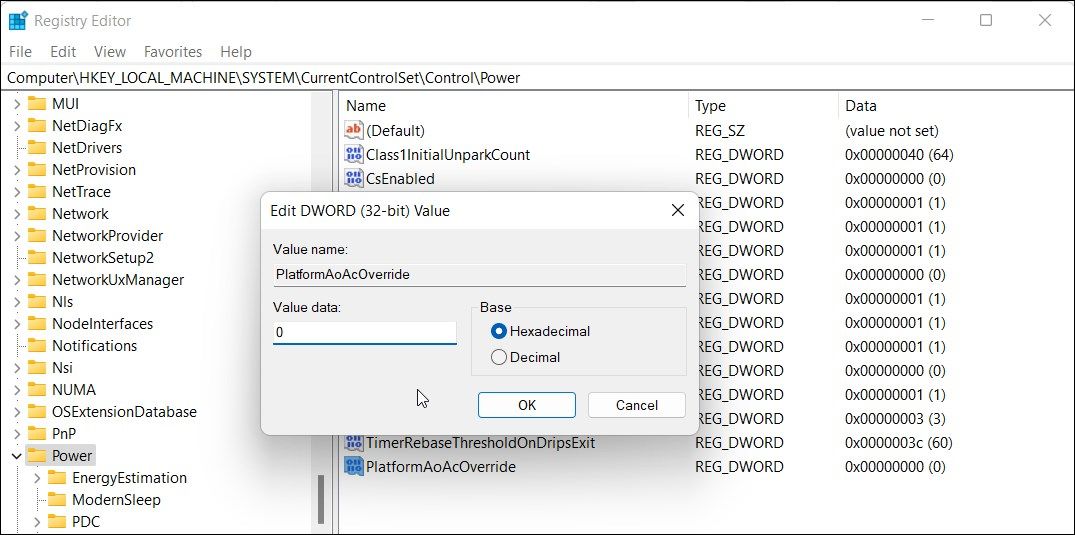В Windows 11/10 был представлен новый режим экономии энергии — Modern Standby (S0 Low Power Idle). Он схож со спящим режимом, но работает иначе, ближе к режиму ожидания на смартфонах или планшетах: система может продолжать получать уведомления, проверять наличие обновлений и выполнять другие фоновые задачи.
Несмотря на то, что Майкрософт рекомендует новый режим, некоторые пользователи могут предпочесть обычный спящий режим (Sleep Standby, S3) из-за проблем с нагревом, разрядом батареи, переходом в спящий режим или по иным причинам. В этой инструкции о том, как отключить режим Modern Standby.
Отключение Modern Standby (S0) в реестре
Прежде чем приступить, имеет смысл убедиться, что этот режим поддерживается на вашем компьютере: возможно, проблемы, которые вы пробуете решить, вызваны не им:
- Запустите командную строку, Windows PowerShell или Терминал Windows от имени администратора, для этого можно использовать контекстное меню кнопки «Пуск».
- Введите команду
powercfg -a
и нажмите Enter.
- Проверьте, какая информация указана для Ждущего режима (S0).
Если «Ждущий режим (простой S0 для пониженного энергопотребления)» находится в разделе «В данной системе доступны следующие состояния спящего режима», можно продолжать. Если же он расположен в списке недоступных, инструкция не будет актуальной для вас.
В случае, если режим Modern Standby (S0) доступен, его отключение можно выполнить вручную в реестре:
- Нажмите клавиши Win+R на клавиатуре, введите regedit и нажмите Enter.
- Перейдите к разделу реестра
HKEY_LOCAL_MACHINE\SYSTEM\CurrentControlSet\Control\Power
- Нажмите правой кнопкой мыши в пустом месте правой панели редактора реестра и создайте новый параметр DWORD (32-бит), укажите имя PlatformAoAcOverride для него.
- Оставьте значение 0 для него.
- Необязательный шаг: откройте подраздел с именем ModernSleep, если в нём содержатся какие-либо значения, удалите их (клавишей Delete или с помощью контекстного меню по клику правой кнопкой мыши).
- Закройте редактор реестра и перезагрузите компьютер.
То же самое можно сделать быстрее, запустив командную строку от имени администратора и выполнив команду:
reg add HKLM\System\CurrentControlSet\Control\Power /v PlatformAoAcOverride /t REG_DWORD /d 0
после чего, как и в предыдущем случае, требуется выполнить перезагрузку компьютера.
Если вам потребуется вернуть изначальные настройки, удалите созданный вами параметр PlatformAoAcOverride в реестре, либо используйте команду
reg delete "HKLM\System\CurrentControlSet\Control\Power" /v PlatformAoAcOverride /f
в командной строке, запущенной от имени администратора.
Modern standby enables the PC to turn it On and Off instantly much like smartphones, while keeping the network connected. Modern standby is also referred to as a S0 Low Power Idle sleep state, which provides this instant On/Off experience in windows.
Modern Standby (S0 Low Power Idle) keeps your computer in the lowest power mode while allowing apps to receive the latest content, such as incoming email, VoIP calls, Windows updates, etc. Your computer may enter a Modern standby state from any of the following actions:
- Pressing the system power button.
- Closes the lid of the laptop/desktop/tablet.
- Select Sleep from the power button in the Windows Start menu.
- Waits for the system to idle and enter sleep automatically, according to the Power and sleep settings.
The amount of battery saving in Modern Standby is calculated by determining the time the system spends in DRIPS (Deepest Run-time Idle Platform State). DRIPS occurs when the system is consuming the lowest amount of power possible. If any background tasks, such as receiving emails or Windows updates, consume power, the system is not considered to be in DRIPS mode.
Total Modern Standby session time = DRIPS time + non-DRIPS time
As S0 Low Power Idle will remain connected to the network even in low power mode, the battery may run out quicker and may get heated up if left in this state for a long time. Therefore, you have the option to disable it.
Contents
Check If Modern Standby is Supported
Not all devices support Modern Standby, but the number of systems that do is increasing. I have been using a Microsoft Surface Pro 4 laptop, which supports this feature. Here’s how you can check if your device supports Modern standby.
- Open Command prompt on your Windows 10/11 device.
- Type the command
powercfg -ato check if Modern Standby is supported.
powercfg -a command lists the sleep states available on your computer. In the below screenshot, you will find Standby (S0 Low Power Idle) Network Connected state, indicating that Modern Standby is supported and enabled on this device.
If you run the powercfg -a command on your system, and it shows that S0 Low Power Idle is not supported, this could be a limitation of the system’s hardware to support Modern Standby. Unfortunately, there is nothing you can do to enable it. The alternative is to continue using Standby S3 or any other supported power plan.
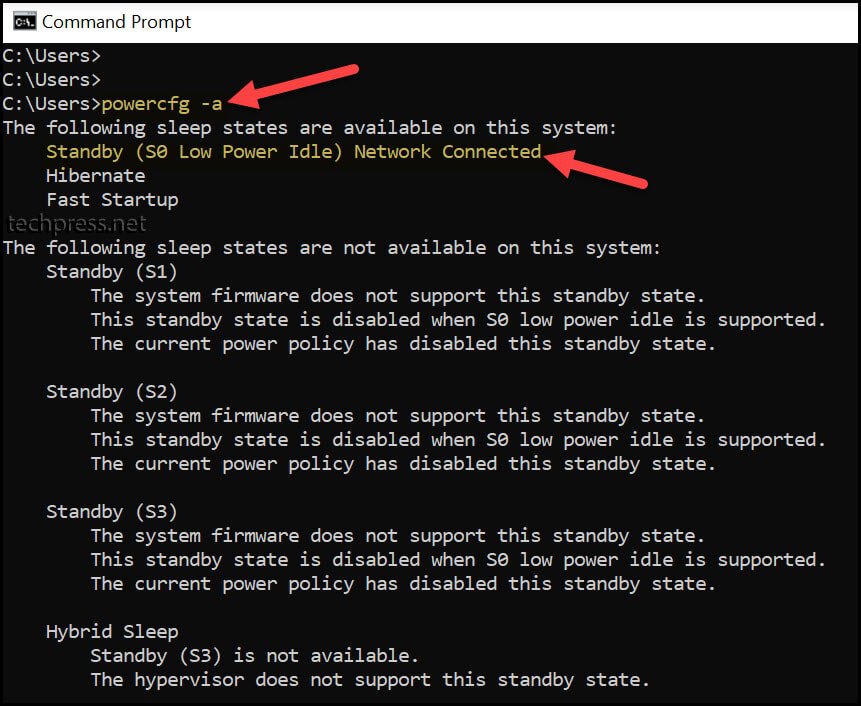
Modern Standby (S0 Low power idle) can be in Network Connected mode or Network Disconnected mode.
- Standby (S0 Low Power Idle) Network Connected: This means that Modern Standby with network connectivity is active in sleep mode.
- Standby (S0 Low Power Idle) Network Disconnected: This means that Modern Standby operates without network connectivity while in sleep mode, and the system spends most of the time in DRIPS (Deepest Run-time Idle Platform State).
- Sign in to the Windows 10/11 device.
- Click on Start and search for Registry Editor.
- Navigate to HKEY_LOCAL_MACHINE\SYSTEM\CurrentControlSet\Control\Power.
- Right-click on the right-hand side pane and click on New > DWORD (32-bit) Value.
- Provide the name of the registry entry as PlatformAoAcOverride and set its value to 0.
- Since this registry change is in HKEY_LOCAL_MACHINE, a restart of the PC will be required.
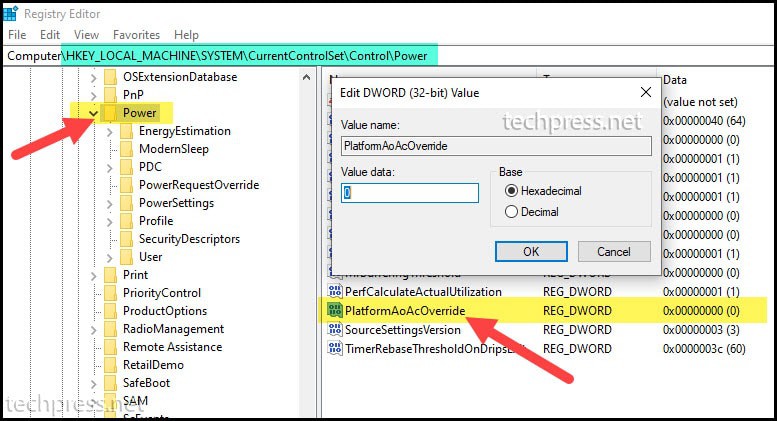
Disable Modern Standby Using Command Prompt
- Open Command prompt on a Windows 10/11 in admin mode.
- Type the following command and press Enter.
- After this command is executed successfully, restart your device.
Disable Modern Standby
reg add HKLM\System\CurrentControlSet\Control\Power /v PlatformAoAcOverride /t REG_DWORD /d 0
Enable Modern Standby
If your device supports Modern Standby and you have created PlatformAoAcOverride registry entry, simply delete it and restart your device to enable Modern Standby again.
You can delete the PlatformAoAcOverride registry entry manually using the registry editor, or launch the PowerShell console as an administrator and run the following command to delete it.
Remove-ItemProperty 'HKLM:\System\CurrentControlSet\Control\Power' -Name PlatformAoAcOverrideFAQs on Modern Standby
1. Which versions of Windows support Modern Standby?
Windows 10 for desktop editions (Home, Pro, Enterprise, and Education) and Windows 11 Operating system.
2. Does my Computer support Modern Standby?
You can easily check this by running the command powercfg -a on the Command prompt. If it shows Standby (S0 Low Power Idle) Network Connected or Standby (S0 Low Power Idle) Network Disconnected, then Modern Standby is supported.
3. How to Identify and Diagnose Issues during a Modern Standby Session?
You can identify and diagnose any issues related to Modern Standby by running the command Powercfg /sleepstudy in an elevated Command Prompt window. You can then analyze the report, which will be generated and saved at the C:\WINDOWS\system32\sleepstudy-report.html location.

4. How to Find All the Switches of Powercfg Command?
Run powercfg /? In command prompt. This will list all available options with detailed information.
Powercfg /?
C:\WINDOWS\system32>powercfg /?
POWERCFG /COMMAND [ARGUMENTS]
Description:
Enables users to control power settings on a local system.
For detailed command and option information, run "POWERCFG /? <COMMAND>"
Command List:
/LIST, /L Lists all power schemes.
/QUERY, /Q Displays the contents of a power scheme.
/CHANGE, /X Modifies a setting value in the current power scheme.
/CHANGENAME Modifies the name and description of a power scheme.
/DUPLICATESCHEME Duplicates a power scheme.
/DELETE, /D Deletes a power scheme.
/DELETESETTING Deletes a power setting.
/SETACTIVE, /S Makes a power scheme active on the system.
/GETACTIVESCHEME Retrieves the currently active power scheme.
/SETACVALUEINDEX Sets the value associated with a power setting
while the system is powered by AC power.
/SETDCVALUEINDEX Sets the value associated with a power setting
while the system is powered by DC power.
/IMPORT Imports all power settings from a file.
/EXPORT Exports a power scheme to a file.
/ALIASES Displays all aliases and their corresponding GUIDs.
/GETSECURITYDESCRIPTOR
Gets a security descriptor associated with a specified
power setting, power scheme, or action.
/SETSECURITYDESCRIPTOR
Sets a security descriptor associated with a
power setting, power scheme, or action.
/HIBERNATE, /H Enables and disables the hibernate feature.
/AVAILABLESLEEPSTATES, /A
Reports the sleep states available on the system.
/DEVICEQUERY Returns a list of devices that meet specified criteria.
/DEVICEENABLEWAKE Enables a device to wake the system from a sleep state.
/DEVICEDISABLEWAKE Disables a device from waking the system from a sleep
state.
/LASTWAKE Reports information about what woke the system from the
last sleep transition.
/WAKETIMERS Enumerates active wake timers.
/REQUESTS Enumerates application and driver Power Requests.
/REQUESTSOVERRIDE Sets a Power Request override for a particular Process,
Service, or Driver.
/ENERGY Analyzes the system for common energy-efficiency and
battery life problems.
/BATTERYREPORT Generates a report of battery usage.
/SLEEPSTUDY Generates a diagnostic system power transition report.
/SRUMUTIL Dumps Energy Estimation data from System Resource Usage
Monitor (SRUM).
/SYSTEMSLEEPDIAGNOSTICS
The system sleep diagnostics report has been deprecated and
replaced with the system power report. Please use the command
"powercfg /systempowerreport" instead.
/SYSTEMPOWERREPORT Generates a diagnostic system power transition report.
/POWERTHROTTLING Control power throttling for an application.
/PROVISIONINGXML, /PXML Generate an XML file containing power setting overrides.Read Next
Заголовок не для кликбейта, а для тех людей, кто как и я уже устали разбираться в проблемах режима сна на их новеньких ноутбуках: вы не сошли с ума! Проблема действительно существует и она остаётся без решения со стороны Microsoft и производителей ноутбуков уже 3 (три!) года!
Суть коротко
В одном абзаце: из-за плохой реализации режима modern standby (он же S0 State), который пришёл на смену обычному режиму сна (он же S3 State), ноутбук может рандомно и без предупреждения включиться у вас в сумке. Следовательно он сожрёт весь заряд в тщетных попытках установить обновления windows (ну куда ж без них), или проверить почту, и оставит вас с пустой батареей в самый неподходящий момент, по дороге раскалив докрасна и ноутбук и всё, что лежало рядом. Чёткого и однозначного решения проблемы нет! Только различные обходные пути, с разной степенью успеха применимые от модели к модели и от вендора к вендору. Вдобавок с этими способами решения проблемы борется Microsoft, постоянно отключая способы отката на S3.
Вдохновения для написания этой статьи мне придало видео от Линуса Себастьяна с канала Linus Tech Tips.
Видео без больших эмоций с описанием проблемы вы можете посмотреть вот тут. (11 минут. На английском языке). Для тех, кому лучше заходит текст, ниже будет выжимка из видео, присыпанная горьким опытом и эмоциями автора.
Теория (немножко)
Когда-то давно, во времена Windows 8, умные головы из Microsoft решили, что было бы неплохо мобильным устройствам на Windows быть более похожими на смартфоны. Чтобы они могли быть подключенными к сети постоянно и делать свои дела даже тогда, когда устройства не находятся во включенном (полностью включенном) состоянии. Так режимы сна на мобильных компьютерах стали отличаться от их аналогов на стационарных.
Картинка от Microsoft с просторов интернета

И пока вся эта новомодная мишура спокойно отключалась в настройках, или просто не особо лезла в повседневную жизнь со своими «улучшениями», никому оно и не мешало.
Но затем грянул ОН: Modern Standby.
Если в режиме S3, питание подаётся только на оперативную память, то в режиме S0, система никогда не бывает «off». (Кавычки не мои. Microsoft и правда издевается на эту тему в своём мануале, как бы намекая, что вариантов сохранить заряд батареи у пользователей нет). Питание будет подаваться и на процессор, и на wifi модуль, чтобы
-
быстро включаться (но с этим и при выходе из обычного сна не было проблем);
-
давать приложениям Microsoft Store проявлять активность (нет, вы серьёзно?);
-
держать подключение к сети активным (зачем?);
-
получать уведомления (зачем мне в сумке уведомления на ноутбук?);
-
играть музыку по bluetooth (must have функция для ноутбука в сумке);
-
слушать микрофон (комментарии закончились).
Могло показаться, что я прикалываюсь, но НЕТ! Это выдержки из официального мануала!
Идеальный ноутбук в режиме сна по версии Microsoft и Intel

Мой случай
Прошлый ноутбук HP у меня был на шестом поколении Intel Core (Core i7 6700HQ). Всё крайне просто: поработал, закрыл крышку и пошёл по делам. Потом открыл крышку и продолжил работу с того же места, где и был. За ночь батарея могла подсесть на 10% (или около того), если отключиться от розетки.
Однако в 2022 сменил ноутбук на более большой и новый ASUS TUF F17 (FX706HCB, Core i5 11400H). Тут то и начались проблемы.
Первый раз обнаружив горячущий ноутбук с половиной заряда в cумке, я подумал, что пропустил какую-то настройку, и что не происходит перехода в сон при закрытии крышки. Потом я начал что-то подозревать, когда подключенный к розетке ноутбук в режиме сна, начал ночью издавать такой шум вентиляторами, что мне его было слышно из соседней комнаты!
Тут вы скажете: «Стоп стоп стоп! Автор накатил сборку винды от Васяна, драйвера накачал с помойки и удивляется, что всё это не работает как задумано!» Но тут есть нюанс: я проводил тестирование на windows 10 pro, windows 11 pro, windows 11 home. Все версии лицензионные, установлены с чистого образа с сайта Microsoft, а поверх установлены последние драйвера и ПО с сайта ASUS для именно этой модели!
Более того, у меня в распоряжении был ноутбук ASUS TUF F15 (FX506HCB, та же модель, только 15 дюймов), с windows 11 home, прямиком из коробки, обновлённый до последней версии windows с самыми свежими драйверами! Итог один: абсолютно случайным образом, ноутбук может:
-
НЕ уйти в сон при закрытии крышки;
-
уйти в сон при закрытии крышки;
-
уйти в сон при закрытии крышки, а потом включиться;
-
сделать вид, что уходит в сон при закрытии крышки (случай не мой, пример будет ниже).
Перемножим комбинации на состояния «подключен»/»не подключен» к розетке и отдельно на «закрыта крышка»/»нажата кнопка сна». Да, поведение разное, даже если в разделе энергопотребление вы задали «сон» и для крышки и для кнопки! Плюс он может из сна включиться и на столе от розетки, и в сумке от аккумулятора. Думаю поведение этого ноутбука можно брать за основу идеального ГПСЧ (Генератор псевдослучайных чисел).
Сначала я искал решение на форумах ASUS и заметил, что проблема характерна не только для линейки TUF, но и для Zephyrus, ZenBook и прочих. Однако видео от Себастьяна стало большим облегчением: это не я дурак! Оно и правда не работает! То есть что бы я ни делал, хорошо не будет. Причём проблема есть и на ноутбуках других вендоров. Вывод?
Вместо вывода

Что делать?
Хоть статья и помечена как Tutorial, стопроцентного решения на данный момент нет.
Но попытаться стоит! Запускаем командную строку и пишем:
powercfg /aВариант вывода командной строки №1

Режим S3 и так включен. Если в вашем ноутбуке проблемы с режимом сна, то можно проверить список ниже в разделе «Что ещё можно проверить».
Вариант вывода командной строки №2

У вас есть шанс вернуть привычное поведение ноутбука. Однако не все модели, судя по отзывам, могут корректно выходить из режима сна S3, а иногда случаются другие проблемы.
Вот тут описан случай один в один с моим, когда после выхода из сна не работают FN комбинации, а вентиляторы крутятся на максимальной скорости.
Если S3 поддерживается, но выключен, нужно добавить параметр в реестр:
"PlatformAoAcOverride"=dword:00000000По пути:
HKEY_LOCAL_MACHINE\SYSTEM\CurrentControlSet\Control\PowerИли вставить вот этот текст в блокнот и сохранить как файл .reg
Windows Registry Editor Version 5.00
[HKEY_LOCAL_MACHINE\SYSTEM\CurrentControlSet\Control\Power]
«PlatformAoAcOverride»=dword:00000000
Примечательно, что судя по тому же мануалу, официально выхода всё же нет. Так как через BIOS режим поменять нельзя, а также нельзя менять режимы S0 и S3 без переустановки ОС (то есть замена настроек в реестре не должна помочь. Может именно потому у меня проблемы с комбинациями клавиш и вентиляторами). А как тогда менять? Вы когда-нибудь видели запрос на выбор режимов S0/S3 при установке? Подскажите, если у вас есть предположения, как читать и понимать вот эти строки из мануала:
Те самые строки
Switching between S3 and Modern Standby cannot be done by changing a setting in the BIOS. Switching the power model is not supported in Windows without a complete OS re-install.
Вариант вывода командной строки №3
Standby (S3)
The system firmware does not support this standby stateВам могут помочь какие-то из вариантов ниже, но также без гарантий
Отключение connected при активном S0
Windows Registry Editor Version 5.00
[HKEY_LOCAL_MACHINE\SYSTEM\CurrentControlSet\Control\Power]
"CsEnabled"=dword:00000000Ещё рабочим вариантом остаётся переводить не в сон, а в гибернацию. Тогда содержимое оперативной памяти пишется на SSD/HDD. В моём случае это не подходит, потому что даже при nvme SSD выход из гибернации медленнее, чем включение с нуля, так как установлено 32Gb RAM.
Ну и когда ничего не помогло, а ноутбук нужен заряженным, можно его просто выключить. Да, мы откатываемся в мезозой эпоху до Windows 2000, когда компьютеры получили поддержку S3 на уровне ОС.
Кстати, помните про случай, когда ноутбук только делает вид, что спит? Вот тот случай. Индикатор мигает, будто компьютер спит, при этом на видео отчётливо слышен шум вентиляторов, причём на высокой скорости. Как тебе такое, Морфей?
Что ещё можно проверить
Вот неполный список того, на что стоит обратить внимание как в случае с S0, так и в случае с S3
-
активные 3D приложения в фоне (не только игры, это может быть wallpaper engine, или что-то похожее);
-
драйвера на материнскую плату и видеокарту(ы) (избитый совет, но проверить стоит);
-
настройки в панели управления, отвечающие за поведение кнопок и крышки ноутбука;
-
настройки в ПО от производителя (всякие помогатели в играх, оверлеи, программы для разгона и т.д.);
-
мощные магниты рядом с герконом. UPD: как верно подметили в комментариях, это не геркон, а датчик Холла. (лично сталкивался с проблемой, что ноутбук случайным образом засыпает открытым на столе. Оказалось среди вещей на столе рядом с ноутбуком был магнит от жесткого диска);
-
UPD. Спасибо @Shirixae за напоминание. Можно поотключать таймеры включения. Чтобы узнать, есть ли они у вас, под администратором запускаем командную строку и пишем powercfg -waketimers. Если что-то в списке есть, то это надо отключить;
-
UPD. Проверьте, имеет ли ваша мышь доступ к пробуждению ноутбука. Диспетчер устройств>мышь>Power Management (или русский аналог)>разрешить этому устройству пробуждать компьютер.
-
UPD. Проверьте, влючен ли WakeOnLan в биос и в настройках сетевых карт. AnyDesk (возможно и другой софт подобного плана) может пробуждать компьютер
-
UPD. Добавление от @nixtonixto
«Активация расширенного BIOS (только для MSI): R.ctrl + R.shift + L.alt + F2, там параметр с картинки перевести в Disable. После этого в спячке замигает светодиод в кнопке питания (в Modern Standby он светится постоянно) и компьютер начнёт засыпать в S3.»
Скриншот биос MSI

UPD для пользователей МакБуков (сам не проверял)
Скриншот из видео, какая настройка запрещает пробуждение для доступа к сети

Ещё пару мыслей
Есть подозрение, что по крайней мере в случае с ASUS TUF, проблема в некорректном переключении между видеокартами (если говорить не о включении в сумке, а о том, что перехода в сон вообще не происходит). В моём ноутбуке установлена Nvidia RTX 3050. И при работе от аккумулятора система отключает карту полностью (карта пропадает из диспетчера). При подключении к розетке карта появляется в системе, но не всегда. Более того и пропадает при отключении от розетки она не всегда! А когда карта активна, то при работе от аккумулятора, процессор не разгоняется выше 1.2Ghz, возможно срабатывает ограничение по суммарному энергопотреблению (но я ловил и комбинацию с работой процессора на полную мощность от аккумулятора одновременно с активной 3050).
Опять видим дикое количество комбинаций работает/не работает/работает медленно
Иногда помогает пройти по кругу 3 состояния переключателя «GPU Mode» в программе ArmoryCrate. Иногда помогает только перезагрузка.
ArmoryCrate

Кстати! На ноутбке ASUS TUF FX506L с карточкой GTX1650 и процессором Core i5 10300H проблем со сном не было. Но там и не было полного отключения видеокарты при работе от аккумулятора.
Надежда?
Под видео Себастьяна отметился один из инженеров Microsoft.
Его комментарий
Disclaimer: I’m a Software Engineer at Microsoft, but I do not work on the OS team. I’m only here as a viewer who is subscribed to the channel. I decided to test out your guys hypothesis and I was able to reproduce it! I setup a test where I had a laptop running Windows Powershell listening on a port while connected to power. Every time a client connected, I would print the time at which the connection was made. From another PC, I would send a packet to that laptop and see the message being printed out. I then put the laptop to sleep, and after five seconds I would send another packet to the laptop. I then waited a minute and resumed the laptop from sleep.
The following behavior would change depending on whether or not the laptop was connected to power while going to the Sleep S0 state:
— If the laptop was connected to power when I hit «Sleep», after resuming from Sleep I would see the powershell window with the messages printed out with the time at which the laptop was asleep
— If the laptop was NOT connected to power when I hit «Sleep», after resuming from Sleep I would see the powershell window with NO messages printed out
— The above behavior would not change independently of what I did with the power cable DURING sleep — that is, even if I removed the power cable during sleep, then sent new packets, after resuming from sleep (with the power cable still disconnected) I would see the messages printed out, meaning the laptop was S0 Network Connected even on battery. Bug reproduced. Btw, the opposite happens if I connect the laptop to power during S0 sleep (no messages are printed).
I will try to contact the OS team with your findings and my test setup

Thanks guys! This is great investigative journalism!*
For reference, my laptop is a Dell Latitude 7420 running Windows 11 22621.819, default UEFI settings.
Powershell code for reference:
On the server (laptop):
«`
> $Listener = [System.Net.Sockets.TcpListener]52134;
> $Listener.Start();
> while($true)
> {
> $client = $Listener.AcceptTcpClient();
> Write-Host(«Connected at » + $(Get-Date));
> $client.Close(); > }
«`On the client (another pc on the same network):
«`
> $hostIp = «<machine network ip>»
> $port=»52134″
> (new-object Net.Sockets.TcpClient).Connect($hostIp, $port)
«`
Коротко и по-русски: проблема есть, она воспроизводится (даёт скрипты для power shell для тестирования). Он не отвечает за разработку ОС, но передаст информацию в ту сторону.
Так что теоретически когда-нибудь проблема может быть решена. И те, кто не перейдут на MacBook и не разобьют в ярости свои устройства, смогут пользоваться ноутбуками как ноутбуками, без смартфоновских замашек.
Только зарегистрированные пользователи могут участвовать в опросе. Войдите, пожалуйста.
Вы сталкивались с проблемами режима сна на новых ноутбуках
5.4% Сталкивался, решил131
35.75% Сталкивался, не решил!!!868
11.08% У меня linux, проблем нет269
2.31% У меня linux, такая же проблема56
9.39% У меня ноутбук одного из прошлых поколений228
4.74% Поздно, я уже сошёл с ума от этой проблемы!115
12.36% Не использую режим сна300
Проголосовали 2428 пользователей. Воздержались 283 пользователя.
Modern Standby is the upgraded version of the Sleep mode in Windows with its benefits and issues, so here is how you can enable or disable it.
The Modern Standby feature, also technically known as the S0 Lower Power Idle mode, is the newer version of power saving mode for portable computers, tablets, and laptops. This feature was introduced back in 2020 that enables Windows users to experience a mobile-like feel to maintain battery levels without affecting performance.
Suppose you lock your phone, but the background processes like network connection or playback music keep running in the background. Similarly, in the Modern Standby state, your portable laptop won’t experience any slow startup issues and will support a faster transition between on/off state. However, it comes with flaws that can cause hardware damage under a long-term sleep state, and some users may wish to disable it.
Therefore, we have written a comprehensive guide on how to enable or disable Modern Standby in Windows 10 and Windows 11 by following three easy methods. We will also guide you on how to check your computer’s current sleep state.
How to Check Your Computer’s Sleep State?
Whether you want to enable or disable the Modern Standby, first, by following these steps, you must check your computer’s sleep state to see if your device supports the feature.
- Go to Start Menu and type CMD to find the Command Prompt.
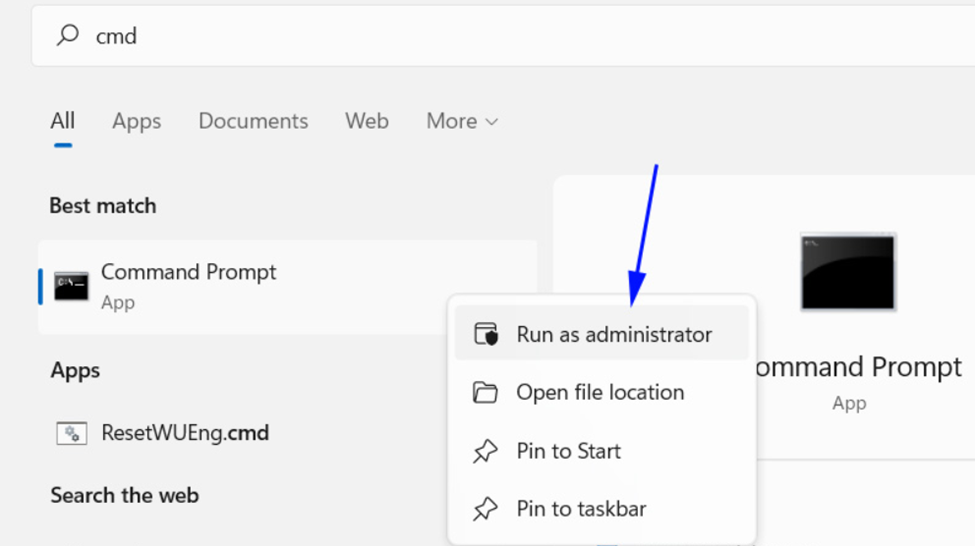
2. Right-click on it and select ‘Run as Administrator.’
3. Type powercfg/a and press the ‘Enter’ key.

4. You will see different messages stating power states, which denote the following processes.
Check Standby (S0 Lower Power Idle) Network Connected/Disconnected as it means the Modern Standby is enabled.
Now check the Standby (S3) to see if it says, ‘This standby state is disabled when S0 low power idle is supported’ which denotes that you can switch the Modern Standby into S3 more power-saving mode (also known as Legacy Standby).

If the message on S3 says, ‘the system’s firmware doesn’t support the S3 sleep state’, then you’ll have to check the BIOS settings to see if there is an option to enable the S3 state in the system. Once S3 is enabled, you can disable S0 by editing the registry.
Also Read: How to Open BIOS Settings On Windows 11?
Disabling Modern Standby in Windows 10 and 11
Once you have checked the Sleep state of your computer system, you can follow these three step-by-step methods to enable or disable the Modern Standby in Windows 10 and 11.
Method #1: Enable/Disable Modern Standby via Windows Registry
This is a straightforward method to manually enable or disable Modern Standby from the Registry by following these steps.
- Press the Win+R key to open the Run dialogue. Type regedit and press ‘Enter’ to run it.
- Paste the following path in the navigation bar to open the specific folder HKEY_LOCAL_MACHINE\SYSTEM\CurrentControlSet\Control\Power

3. Right-click the ‘Power’ folder and select New > DWORD (32-bit) Value from the pop-up menu.
4. Right-click on this new value to rename it as PlatformAoAcOverride.
5. Again, right-click on the PlatformAoAcOverride and select ‘Modify.’

6. Set the value ‘1’ to enable it and ‘0’ to disable it.
7. Exit the Windows Registry to Reboot your computer system, and you’re all done.
Also Read: How to Bypass Windows 11 TPM 2.0 Check and Secure Boot?
Method #2: Enable/Disable Modern Standby via Registry Script
Another direct yet easy method to enable or disable the Modern Standby for your computer system is with the help of Registry Script, which can be performed by following these steps.
- Open the Run dialogue by pressing Win+R.
- Type ‘Notepad’ and press Enter key to open a new TXT Notepad file.
- Paste the following command in the Notepad by typing
Windows Registry Editor Version 5.00
[HKEY_LOCAL_MACHINE\SYSTEM\CurrentControlSet\Control\Power]
“PlatformAoAcOverride”=dword:00000000
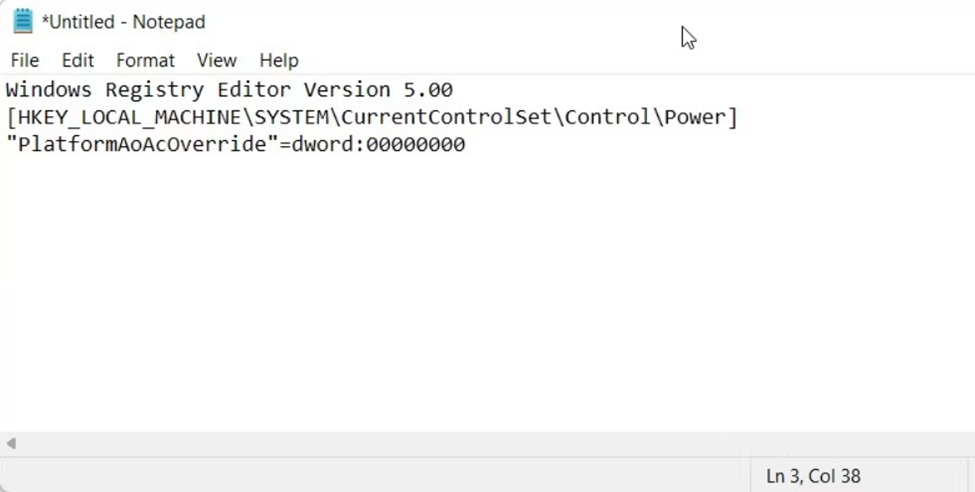
4. Choose File > Save As > Save as type and select All files.

5. Rename the file as ‘Disable_Modern_Standby.reg’ to disable and ‘Enable_Modern_Standby.reg’ to enable the Modern Standby and click ‘Save’ to create the file.
6. Restart your computer system to apply the changes
Before enabling or disabling the file via registry script, run the files after saving them and then restart your computer system to apply changes.
Also Read: Windows 11 – How to Fix Random Black Screen
Method #3: Enable/Disable Modern Standby via Command Prompt
Once you have checked the Sleep state of your computer system, the simplest method to enable or disable Modern Standby is using the Command Prompt by following these steps.
- Go to Start Menu and type Command Prompt.
- Right-click on Command Prompt and select ‘Run as Administrator.’

3. To disable Modern Standby, paste the following command reg add HKLM\System\CurrentControlSet\Control\Power /v PlatformAoAcOverride /t REG_DWORD /d 0
To enable Modern Standby, paste the following command reg delete “HKLM\System\CurrentControlSet\Control\Power” /v PlatformAoAcOverride /f
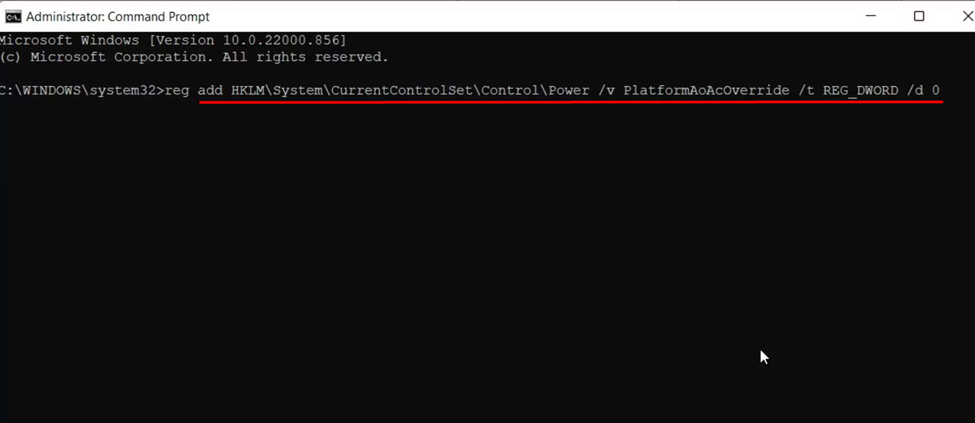
4. After entering the command, press Enter key and reboot your computer system to apply changes.
Also Read: Windows 11 Startup Repair (4 Easy Ways)
Final Words
With all the new advantages to make portable laptops more energy efficient, Modern Standby is not the right fit for many Windows users. Instead of sleep mode, setting your system on hibernate is much better to avoid any hardware damage resulting in poor battery health or hardware heating issues. Moreover, if you have upgraded to Windows 11, consider optimizing the power usage of your PC to enhance battery life.
FAQ
How to Disable Active Sleep in Windows 11?
Open Settings and go to System > Power & Battery. Select ‘Screen and sleep’ under the Power section and set it to ‘Never’ to prevent your computer system from automatically sleeping.
Should Your Disable the Modern Standby in Windows?
With the Modern Standby enabled, your laptop’s battery will drain faster, which can cause heat damage to hardware and reduce the lifespan of battery cells. Hence it is recommended to disable the Modern Standby to maintain the battery health of your portable computer.
Why can’t I find Sleep in Windows 11?
The ‘Sleep’ option could be missing in the Control Panel because of the graphics drivers. The best way to fix this issue is by reinstalling, updating, or downgrading the graphics drivers to see which one is compatible.
What is the difference between the Sleep state and Modern Standby mode?
The Sleep mode is much like shutting down the PC, where all the components of the laptop power off, and it takes a rather extended path to do so as compared to the Modern Standby, where only those components are powered off that are not being used. Ultimately, Modern Standby gives a quicker transition between on/off as compared to the sleep mode.
Hi there! I’m a passionate content creator and gamer. Being devoted to making a difference through my publications, I chose to blog for a career to share my knowledge and expertise in gaming technology. Compiling my tech knowledge and gaming experience, I am here to bring you the latest updates and news from the gaming world. Follow me on Twitter .
Windows’ Modern Standby (S0) replaces the classic S3 lower power mode in Windows 10 and 11. On a Modern Standby-compatible system, the feature adds better power management for connected devices.
While there are other perks to using Modern Standby, not everyone prefers it over the classic S3 sleep mode. If, for any reason, you need to disable Modern Standby in Windows 10 and 11, here we show you how.
What Is Modern Standby on Windows, and Why Should You Disable It?
Introduced in 2020, Modern Standby (S0) is a newer sleep state and a successor to the legacy Sleep Standby (S3) mode. It replaces the standard sleep feature and puts your laptop in a lower power state when idle.
In this sleep state, your system is kept awake under minimum power consumption to perform background tasks such as syncing email and notifications over the Internet, etc.
It also features an instant on/off feature that gives you a faster transition between the on and off state, similar to your smartphone.
On the flip side, Modern Standby is reportedly causing heating and battery draining issues, thus forcing some users to turn off the new power mode on their laptops.
Note that poor battery life and heating issues with your laptop are common occurrences and can happen due to several reasons. Also, due to the nature of Modern Standby, which requires the CPU to participate all the time, a moderate increase in CPU temperature is expected.
Before you decide to turn off Modern Standby, try these tips to improve battery life on Windows 11. You can also set a battery charge threshold for your laptop to increase the battery life span. Additionally, you can also troubleshoot your laptop for overheating issues by understanding the basics of overheating computers.
If you still need to disable Modern Standby in Windows 11, proceed with the steps below.
How to Check Your System’s Current Sleep State
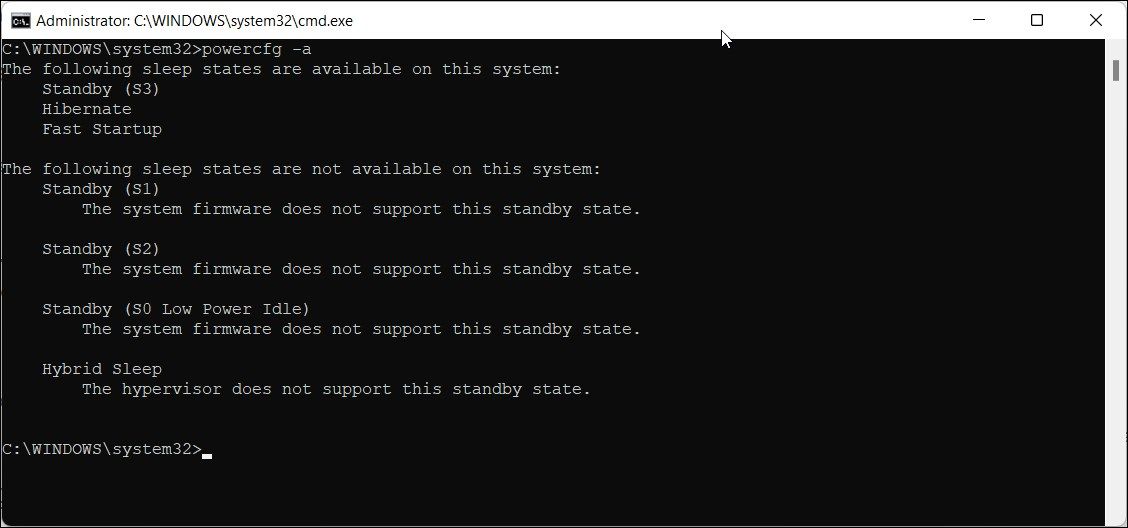
You can use the powercfg /a command in Command Prompt to view and configure your system’s available sleep state. Here’s how to use this command in Windows 11:
- Press Win + X to open the WinX menu.
- Next, click on Windows Terminal (Admin).
-
In the Windows Terminal window, type the following command and press Enter to execute:
powercfg /a - If the system reports, Standby (S0 Lower Power Idle) Network Connected/Disconnected, then you have Modern Standby enabled.
- Next, check Standby (S3) status. If you see the «This standby state is disabled when S0 low power idle is supported» message, it means you can disable Modern Standby to enable Legacy Standby (S3).
1. How to Disable Modern Standby Using a Registry Script
You can use a registry script to disable Modern Standby in Windows 11 and 10. This is the easiest way to get things done without having to navigate your way through the Windows registry.
Before you attempt to make any changes to your Windows registry, we strongly recommend you create a restore point. This should help you recover your system in case something goes awry during the process.
- Press Win + R to open Run.
-
Type notepad and click OK to open a new Notepad file.
-
Copy and paste the following script into the notepad file:
Windows Registry Editor Version 5.00
[HKEY_LOCAL_MACHINE\SYSTEM\CurrentControlSet\Control\Power]
"PlatformAoAcOverride"=dword:00000000 -
Next, click on File and select Save As.
- Enter the File name as Disable_Modern_Standby.reg.
- Next, click the Save as type drop-down and select All files.
- Click Save to save the registry file.
- Next, double-click on the Disable_Modern_Standby.reg file and click Yes when prompted by UAC.
- Restart your PC to apply the changes.
If you need to re-enable Modern Standby, copy and paste the following script into a new Notepad file:
Windows Registry Editor Version 5.00
[HKEY_LOCAL_MACHINE\SYSTEM\CurrentControlSet\Control\Power]
"PlatformAoAcOverride"=-
Save the file as Enable_Modern_Standby.reg. Next, double-click on the saved file and wait for the script to execute. Restart your PC to see if Modern Standby is enabled.
To confirm the changes, execute the powercfg /a command in elevated Command Prompt. If the Legacy Standby (S3) is enabled, you will see the following:
The following Sleep states are available on this system:
- Standby (S3)
- Hibernate
- Fast Startup
2. How to Disable Modern Standby Using the Command Prompt
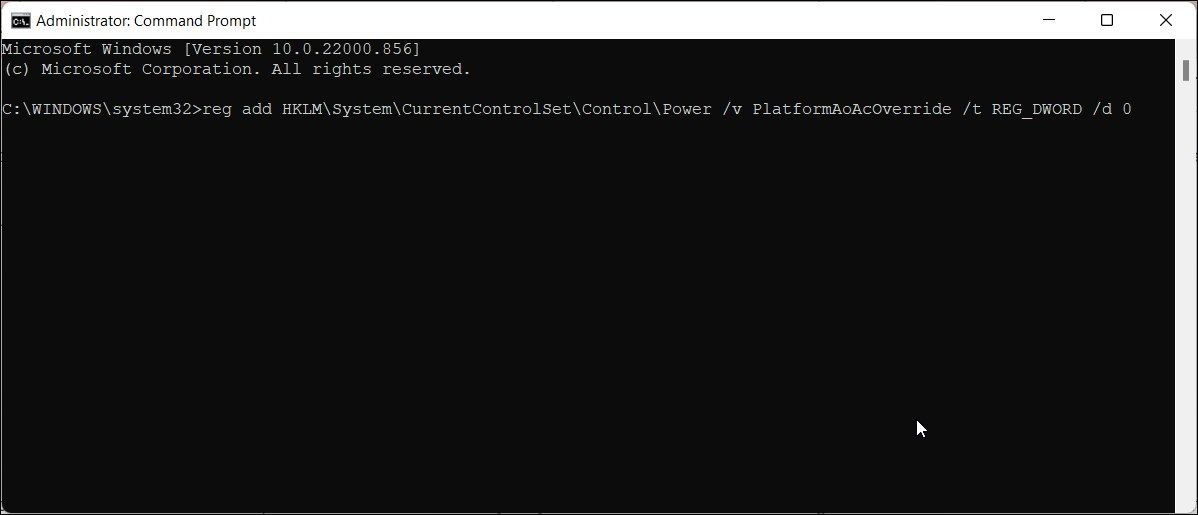
You can use the Command Prompt to disable Modern Standby on your PC. This method uses the reg commands executed via the Command Prompt to modify the Windows registry.
Follow these steps to turn off Modern Standby in Windows 11 using the registry commands:
- Press Win + X to open Run.
- Click on Windows Terminal (Admin) to open the terminal with administrative privilege.
-
In the Windows Terminal window, copy and paste the following reg command:
reg add HKLM\System\CurrentControlSet\Control\Power /v PlatformAoAcOverride /t REG_DWORD /d 0 - When the operation completed successfully message appears, close the Command Prompt.
-
If you need to enable Modern Standby again, use the following command in the elevated Windows Terminal window:
reg delete "HKLM\System\CurrentControlSet\Control\Power" /v PlatformAoAcOverride /f - Make sure you restart your PC to apply the changes.
You can use the aforementioned powercfg /a command to view the sleep status and confirm the changes.
3. How to Disable Modern Standby Using the Registry Editor
If the script and the reg command don’t work, you can manually modify the necessary registry entry to disable Modern Standby. Here’s how to do it:
- Press Win + R to open Run.
-
Type regedit and click OK to open Registry Editor. Click Yes if prompted by UAC.
-
In the Registry Editor, navigate to the following location. You can copy and paste the registry path into the Registry Editor for quick navigation:
HKEY_LOCAL_MACHINE\SYSTEM\CurrentControlSet\Control\Power -
Here, right-click on the Power subkey and select New > DWORD (32-bit) Value.
- Rename the value as PlatformAoAcOverride.
- Right-click on the PlatformAoAcOverride value and select Modify.
- In the value data field, type 0 and click OK.
- Close the Registry Editor and restart your PC.
Disable Modern Standby in Windows 10 and 11
Modern Standby, with all its advantages, doesn’t fit the bill for everyone. For many users, Modern Standby has resulted in poor battery life and heating issues.
You may work around this issue by setting your device to hibernate instead of sleep when you close the lid. Additionally, consider optimizing your power usage in Windows 11 to increase your battery life.

